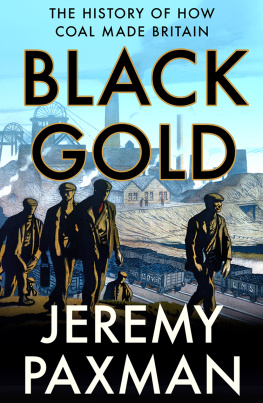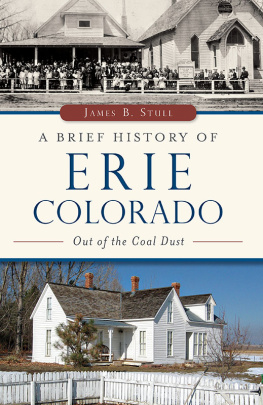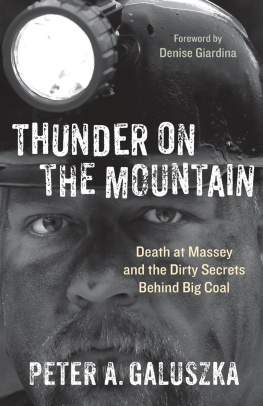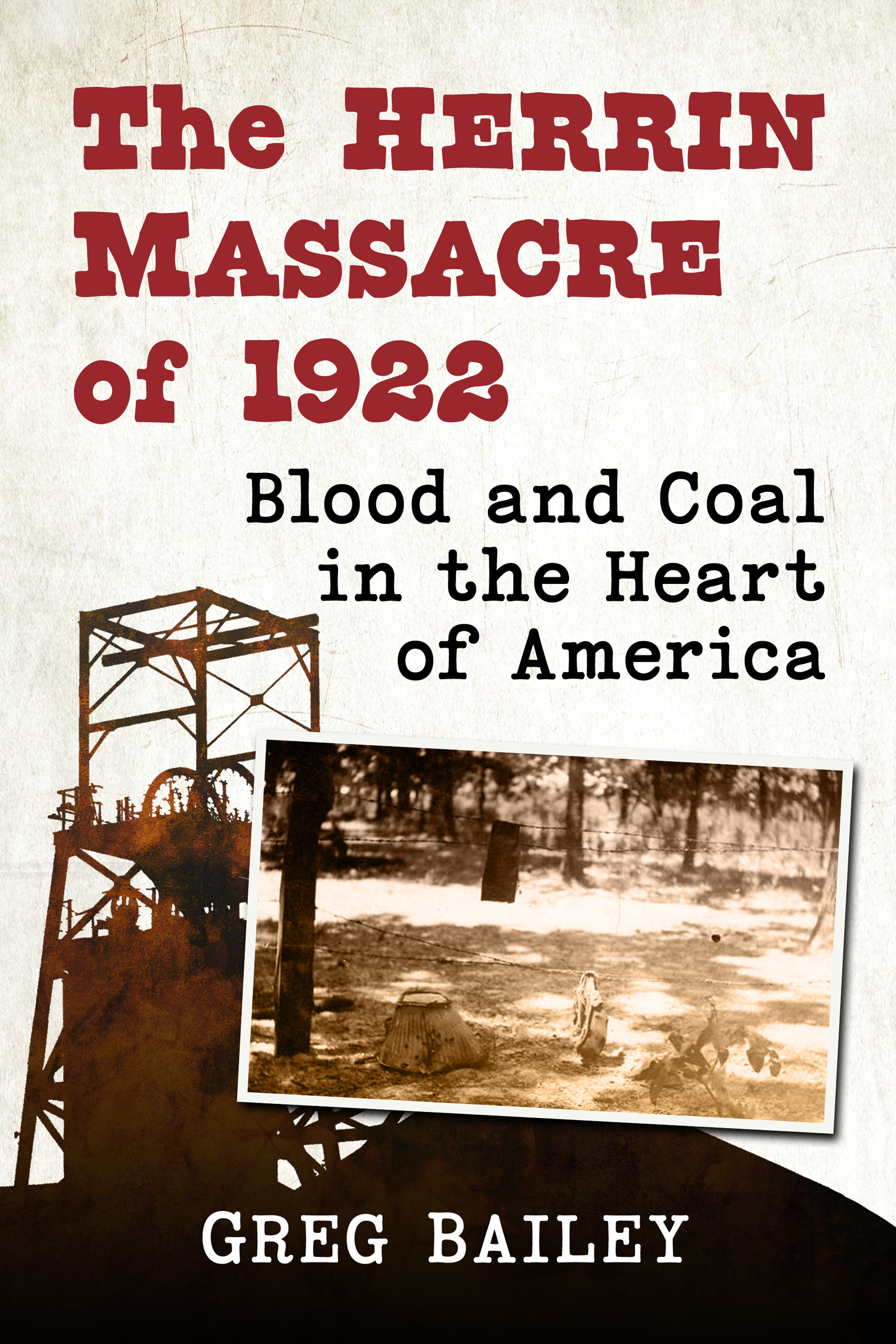The Herrin Massacre of 1922
Also edited by Greg Bailey
The Voyage of the F.H. Moore and Other 19th Century Whaling Accounts (McFarland, 2014)
The Herrin Massacre of 1922
Blood and Coal in the Heart of America
Greg Bailey

McFarland & Company, Inc., Publishers
Jefferson, North Carolina
Library of Congress Cataloguing-in-Publication Data
Names: Bailey, Greg, 1954 author.
Title: The Herrin Massacre of 1922 : blood and coal in the heart of America / Greg Bailey.
Description: Jefferson, North Carolina : McFarland & Company, Inc., Publishers, 2020 | Includes bibliographical references and index.
Identifiers: LCCN 2020045128 | ISBN 9781476681719 (paperback : acid free paper) ISBN 9781476642215 (ebook)
Subjects: LCSH: Strikes and lockoutsCoal miningIllinoisHerrinHistory20th century. | StrikebreakersIllinoisHerrinHistory20th century. | Coal minersLabor unionsIllinoisHerrinHistory20th century. | MassacresIllinoisHerrinHistory20th century. | Herrin (Ill.)History20th century.
Classification: LCC HD5325.M6152 1922 B35 2020 | DDC 331.892/8223340977399309042dc23
LC record available at https://lccn.loc.gov/2020045128
British Library cataloguing data are available
ISBN (print) 978-1-4766-8171-9
ISBN (ebook) 978-1-4766-4221-5
2020 Greg Bailey. All rights reserved
No part of this book may be reproduced or transmitted in any form or by any means, electronic or mechanical, including photocopying or recording, or by any information storage and retrieval system, without permission in writing from the publisher.
Front cover: inset photograph of wire fence where massacre began (Williamson County Historical Society); background images (c) 2020 Shutterstock
Printed in the United States of America
McFarland & Company, Inc., Publishers
Box 611, Jefferson, North Carolina 28640
www.mcfarlandpub.com
To Sue
I will show you fear in a handful of dust.
from The Waste Land by T.S. Eliot (1922)
Table of Contents
Authors Note
This book is based on one premise: the people accused in the Herrin Massacre, despite the acquittal of a few and the decision to drop further prosecutions, did in fact commit the crimes for which they were indicted and many others uncharged. They committed the murders, carried out the torture and spoke the words described by witnesses. These allegations are treated as facts because they are facts. As in any human activity, there are some disagreements and disparities between the witnesses, but the author has attempted to present the most accurate and true story. The author bears full and sole responsibility for these choices and stands by them.
Newspapers of the day were constrained by custom from running profanity instead substituting dashes in the middle of words. The author has filled in the dashes.
Introduction
There are many chapters in the history of coal. On a June morning in 1922 a small mining town in southern Illinois became for a time the most famous, or infamous, place in the world. On that day and the day before, 23 people were murdered in what the world remembered and has now largely forgotten as the Herrin Massacre.
There were more violent episodes in American history, as crudely measured in body counts, but never before or since has a mass murder been committed by a crowd of hundreds in full view of, and to the cheering approval of, thousands of witnesses.
That morning the crowd roared its approval as they watched six men bound together as they were shot, cut and mutilated to deathand after death. When the killing stopped, the crowd placed the torn, bloody bodies of the dead on public display and brought their children into the hall to spit on the corpses. Many details about what happened before, during and after the massacre are unknown, lost to history. Based on available evidence, what follows is the best possible account of the people, places and events, with the admission that it is not perfect and that some questions remain unanswered.
The murderers and their supporters were not hardened criminals. Most of them had never broken the law, at least not seriously, before that day. They could not claim the excuse of poverty or desperation. They were living better than most Americans of that time, certainly better than most people in their region in the 1920s. They were not monsters. They were the grandparents and parents of the present generation. They were like us. They were us.
What, in the end, did the Herrin Massacre accomplish? Coal mining was once one of the most important industries in America and the world. Now, due to changes in technology and economics, as well as environmental concerns, coal is in decline. Like wooden ships, home ice delivery, vacuum tube radios and televisions and horse-drawn transportation, the end of coal is in sight.
Coal may be leaving the United States, The share of coal burning power production fell to 28 percent in 2018, down 8 percent from the previous year. To compound the decline coal exports to that shrinking number of countries still burning coal fell 20 percent in 2015.
The decline of the use of coal is not a recent phenomenon. As the era of sail gave way to steam-powered ships fueled by coal burning boilers, coal became a vital strategic resource. Coaling stations were created around the world to resupply the navy. Ships consumed up to 10 tons of coal per hour, requiring back breaking labor from stokers to keep the fires going. After the USS Maine blew up in Havanas harbora disaster most likely caused by coal dustplunging the United States into the Spanish American War, the operations of the fleet were at the mercy of the coal supply. The navy began reevaluating its earlier decision to reject oil fueled ships. By 1910, the conversion was underway along with the federal governments creation of oil reserves. Across the Atlantic in 1911 the British Royal Navy under the leadership of Winston Churchill converted the fleet to oil despite the abundant coal reserves at the time in Great Britain. The move prompted Churchill to invest government funds in the newly opened oil fields of the Middle East. The last coal fired American ship the USS Texas was commissioned in 1914 and two years later the first oil fueled battleships were launched. By 1925, the USS Texas was converted to oil, ending the naval coal era because of technological and economic forces still in effect today on the land.
Former New York City mayor Michael Bloomberg recently pledged a half a billion dollars for a campaign called Beyond Carbon to eliminate coal in the United States and close the remaining 241 coal fired power plants by 2030. The UK has begun celebrating days, weeks and months of coal free electric production.
Wishful thinking and empty rhetoric has not slowed the decline of coal. In 2016 candidate Donald Trump in the middle of a crowd of supporters holding Trump Digs Coal signs he promised to bring back coal mining. We will put our miners back to work he said. At one rally he wore a hard hat and mimed shoveling coal. Three months after taking office and appointing coal industry executives and lobbyists to the Environmental Protection Agency and the Department of the Interior he declared victory. However, despite gutting regulations on coal fired plants and propping up the coal industry the reality is quite different. According to an article in the New York Times in October 2020, under Trump coal has continued its free fall. Coal generated power has fallen 15 percent over his term as 75 power plants have shut down 145 generators. Another 75 plants have announced plans to shut down their generators by the end of the decade. Coal now accounts for 20 percent of electric power, down from 31 percent in 2017. According to the New York Times coal production will drop from 775 million tons to an expected 511 million tons in 2020 as 5,300 mining jobs have disappeared, amounting to ten percent of the workforce under Trumps watch. General Electric recently announced it will no longer sell new coal fueled generators. At the cost of water polluted by coal waste, dirtier air, ravaged public lands opened to mining operations, shattered dreams of desperate communities, coal is not back. In 2017 the Kentucky Coal Museum installed 80 solar panels on its roof to power the building and other parts of the town of Benham. It was simply cheaper. And as if to emphasize the downturn or perhaps downfall of coal, Robert Murray, former CEO of Murray Energy Corp. and in the past a leading crusader against federal mine regulations, has contracted black lung disease and is applying for the federal benefits he fought so hard for years to deny to his employees and other miners.









